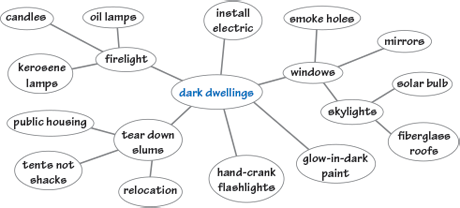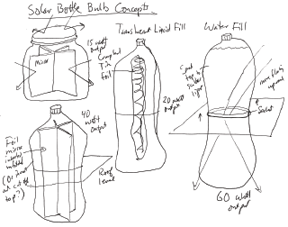Web site: Massachusetts Institute of Technology
Problem Solving in Action
The following pages explain the problem-solving process using an example that began with students at the Massachusetts Institute of Technology. Their solution to a real-world problem is now making a huge difference for many of the world’s poor.
Analyze the Problem
The first step in the problem-solving process is to understand and analyze the problem. Use one or more of the thinking techniques that you learned in chapters 2 and 3 of this book:
Critical-Thinking Strategies | Creative-Thinking Strategies |
Real-World Example
Around the world, millions of people live in slums, in shacks that are so tightly crammed that no light can enter the living spaces. For most of these homes, electricity and fuel for fires is unavailable. Millions of people spend their days and nights in darkness. A group of MIT students decided to do something about the situation. They began by analyzing the problem.
Tracing Causes and Effects

Your Turn Consider the problem you identified on the previous page or choose another. Analyze the problem by considering its causes and effects.
Imagine and Plan Solutions
After thoroughly analyzing a problem, you need to brainstorm and plan solutions. Use one or more of the thinking strategies you learned in chapters 2 and 3:
Critical-Thinking Strategies | Creative-Thinking Strategies |
Real-World Brainstorming
After thoroughly analyzing the causes and effects of the dark dwellings of the world’s poor, the MIT students started brainstorming solutions. One way to do this is to create a cluster, writing down as many ideas as possible without judging them.

Your Turn Brainstorm solutions to the problem you analyzed on the previous page. If possible, work with another student or a group to produce many solution ideas.
Real-World Planning

The students at MIT decided to work on an inexpensive solar light bulb made from readily available materials. They designed and prototyped their ideas, testing to find the best solution.
Your Turn Select a solution from the ideas you generated above and plan how you could create the solution.
Create and Evaluate the Solution
Once you have planned a solution, you need to launch into creating and evaluating the solution. Use one or more of the strategies that you learned in chapters 2 and 3.
Critical-Thinking Strategies | Creative-Thinking Strategies |
Real-World Creating
After the MIT students tested many possible designs, they settled on a simple structure built from a discarded liter soda bottle, water, chlorine, and a piece of flashing (sheet metal).
Real-World Evaluating
The bulb inventions worked well, but there is always room for improvement. A trait evaluation can pinpoint ways in which the design is working well and ways in which it could work better.
Trait Evaluation: Solar Bottle Bulbs
Trait | Evaluation | Improvements |
Light production | Most liter bulbs transfer as much sunlight as a 60-watt bulb, though bleach-scoring of plastic can reduce glow. | Experiment to find the optimal amount of bleach to keep water and plastic clear. |
Expense | The liter bottles are free. The sealant and some types of flashing are the main expense. | Investigate most durable but least expensive flashings and sealants. Get donations? |
Ease of installation | Many roofs are made of corrugated metal, so we need a way to cut the metal. | Let’s work on a low-tech metal-cutting technique. |
Your Turn Imagine that you have applied your solution. Perform a trait evaluation to decide on improvements.
Improve and Implement the Solution
After evaluating the solution, it’s time to make changes that improve it and then to implement the solution in its real-world context. Use one or more of these strategies from chapters 2 and 3.
Critical-Thinking Strategies | Creative-Thinking Strategies |
Real-World Improving and Implementing
The team found the exact right amount of bleach to use to keep the bottle lights shining for years. They also discovered that some plastic bottles crumpled too easily or didn’t hold up to the weather. They made many adjustments to increase the light yield, decrease the expense, make implementation easier, and maximize the longevity of the design. In addition to making physical improvements in their design, the students partnered with an organization called “Isang Litrong Liwanag,” which is Filipino for “A Liter of Light.” (Go to aliteroflight.org to learn how you can help.)
Your Turn Go to aliteroflight.org to see how this organization is taking the ideas of students and turning them into real change in the world.
